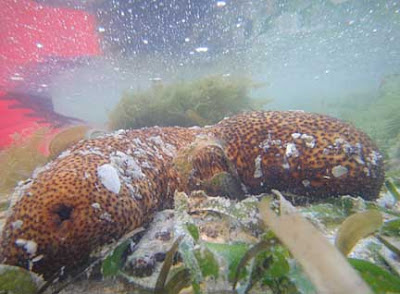We were surrounded by Knobbly sea stars as soon as we landed!
Thanks to Clarence who gathered the NParks team for the trip. Here Clarence examines a seaweed and discovers just how slimy they can be. Seaweeds are slimy to protect themselves, from water loss and possibly also nibbly animals.
There's lots of photos to take at Cyrene. Here's Ben and Mr Chua nailing shots of the reef egrets we saw there.
The NParks team is really great at spotting marine life! Thankfully, as I'm rather blind. They have not only found the Polka-dotted nudibranch (Jorunna funebris) but also found one near what is possibly their food source, the bright Blue jorunna sponge (Neopetrosia sp.)! It seems to be laying an egg ribbon near the sponge! So far, I've only encountered this situation at Pulau Sekudu, many years back.
Yusoff has found a Cushion sea star (Culcita novaeguineae)! From above it looks just like a stone and is well camouflaged. It is only when we gently look at the underside that it becomes obvious that it is a sea star, although a very round and fat one.
What is interesting about the Knobbly sea stars (Protoreaster nodosus) on Cyrene is that we find many small ones here. According to the Star Trackers, Cyrene probably has the largest population of these Endangered sea stars, and the only one with a viable, reproducing population of these magnificent sea stars. So we look for the smallest instead of the biggest sea star! Isnarti has found one of the smallest ones today!
Cyrene also has lots of Common sea stars (Archaster typicus) which are considered Vulnerable, and plenty of Cake sand dollars (Arachnoides placenta). We also saw some tiny White sea urchins (Salmacis sp.).
Cyrene is full of echninoderms! And I finally saw the Brown sea cucumber (Bohadschia vitiensis) for myself. This special sea cucumber had been seen earlier by Kok Sheng on Cyrene.
We also saw lots of Black long sea cucumbers (Holothuria leucospilota) and many Garlic bread sea cucumbers (Holothuria scabra). Both these sea cucumbers are listed as Vulnerable on the Singapore Red List.
There were plenty of Fan shells (Family Pinnidae) on the shore. Even when they die, these clams are precious for other marine life. Like this little Variable fang-blenny (Petroscirtes variabilis) which has laid eggs on the inside of the shell.
And vigorously defends the nest against intruders!
 |
| The layer of eggs are on the lower portion of the photo. |
Yvonne is is the star finder of the day! She found not one but two of these Grey bonnet snails (Phalium glaucum). She found one of them on a sand dollar which is believed to the the prey of these snails. A gruesome account of how the snails feed goes like this: "The snail first squirts neurotoxic saliva over its prey to paralyse the spines. The snail is initially protected from these spines by the thick skin of the foot. Then, the snail pushes its snout through the unprotected anus, or through a hole bored through the skeleton of the victim which may also be crushed under the weight of the snail."
 |
| The snail 'snorkels' through its siphon which is held upright through the notch in the shell. |
Isnarti found a Spider conch (Lambis lambis)! She later also found a Top shell snail (Trochus niloticus). Both these large spectacular snails are listed as Vulnerable on the Singapore Red List.
We had a quick look at the reefier side of Cyrene. I was glad to see some hard corals in their normal colours. Like our other reefs and reefs worldwide, corals on Cyrene were affected by coral bleaching which is caused by the elevated sea temperatures worldwide last year. It was good to see healthy individuals of these species which were badly affected by coral bleaching last year. More about coral bleaching on Bleach Watch Singapore.
 | |
| Top row: Anemone coral (Goniopora sp.), Cauliflower coral (Pocillopora sp.) Bottom row: Leathery soft coral (Family Alcyoniidae), Asparagus soft coral (Family Neptheidae) |
Wow, is this a colourful jellyfish?! Although disturbing, I am glad we spotted this. No, it is an exploded balloon. Here, we can see why sea turtles, which eat jellyfishes, can mistakenly swallow balloons that explode and end up in the sea. This is why balloon releases are a tragic practice.
This amazing shore is in the middle of the "Industrial Triangle". Here is the Pasir Panjang Container Terminals on the horizon.
And on the other horizon, the massive industrial installations at Jurong Island, with a spectacular sky. There are plans to reclaim the portion of Jurong Island near Cyrene Reef. Hopefully, this will not affect Cyrene too badly.
Also on Cyrene today was a team from DHI who are doing some work there. They have to swim to and from Cyrene to their boat.
We left at sunset.
And moonrise!
Thankfully, we had Melvin and the crew from the Dolphin to make a safer landing on and departure from the shore. But it wasn't much drier! There is lots of splashing waves on this shore.
It was such a delight to share Cyrene with the NParks team! Thanks to Clarence for organising the trip, and to everyone for finding stuff and being so sporting.
More about Cyrene Reef!


















